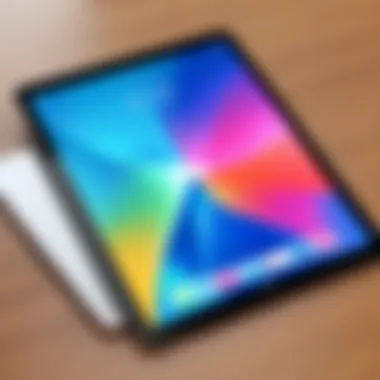Understanding the Largest iPad: Size and Significance


Intro
In the ever-evolving landscape of technology, understanding the nuances of device specifications is crucial. When it comes to Apple's iPad lineup, the largest model offers distinct advantages that affect not just how users interact with their devices but also how they perceive utility. The iPad, regarded for its versatility and high performance, has grown to accommodate a diverse array of user needs. This introduction sets the stage for exploring the largest iPad, shedding light on its unique features and relevance in today’s digital world.
Key Features
Design and Build Quality
The design of the largest iPad is characterized by its sleek aesthetic and robust construction. It combines aluminum and glass to create a lightweight yet durable body. This model is available in multiple colors, catering to a range of user preferences. The corners are rounded, and the bezels are minimized, providing a more immersive display experience. The size of this iPad is a key feature, enabling not only enhanced visuals but also accommodating a larger battery, which is important for prolonged use.
Display and Performance
The display is arguably one of the most impactful aspects of the largest iPad. With a high-resolution Retina display, it offers vibrant colors and crisp details. This is particularly advantageous for tasks such as photo editing or graphic design, where pixel accuracy is paramount. The performance is equally impressive, driven by Apple's powerful chipsets, ensuring smooth operation for demanding applications. Users can seamlessly switch between heavy multitasking and resource-intensive apps without noticeable lag.
Product Specifications
Technical Specifications
The largest iPad comes with various technical specifications that enhance its functionality.
- Display Size: Approximately 12.9 inches
- Resolution: 2732 x 2048 pixels
- Processor: A14 Bionic chip
- Storage Options: 128GB, 256GB, 512GB, or 1TB
These specifications underline the capability of the device to handle professional-grade tasks, making it a viable replacement for traditional laptops in many scenarios.
Compatibility and Connectivity
When it comes to connectivity, the largest iPad is designed to keep users connected in different environments.
- Wi-Fi 6 support for faster network speeds
- Bluetooth 5.0 for improved device pairing
- USB-C port for versatile connectivity options
Additionally, it supports several accessories that enhance its functionality, such as the Apple Pencil and Magic Keyboard. These accessories allow users to maximize the potential of their device, whether they are taking notes during a lecture or crafting complex documents.
"The largest iPad encapsulates the essence of functionality combined with portability, catering to both creative and professional users."
In examining the largest iPad, it becomes clear that its size and specifications are more than just numbers. They represent a potential lifestyle change for users seeking efficiency and comfort in their tasks.
Dimensions of the Largest iPad
The dimensions of the largest iPad hold significant importance in understanding its utility and user experience. As consumers increasingly prioritize functionality and convenience, the size of a device can greatly influence its practical applications. From professional workflows to casual usage, size impacts how the device is perceived in terms of portability and usability. Understanding these dimensions helps tech-savvy individuals in making informed decisions about their investments.
Physical Size Specifications
The largest iPad model, the iPad Pro 12.9 inch, boasts specific physical dimensions that are crucial to its functionality. At approximately 12.9 inches diagonally, the display offers ample screen real estate for multitasking and creative endeavors. The overall dimensions are roughly 280.6mm height by 214.9mm width. This expansive size allows users to work with multiple apps side by side, without compromising on clarity or detail.


Furthermore, the aspect ratio of 4:3 strikes a balance between work and entertainment, allowing for a seamless transition from productivity applications to media consumption. This balance is particularly beneficial for professionals in creative fields who require accurate color representation and detailed graphics. The size specifications are not merely numbers; they signify the largest iPad's capability to enhance productivity and creativity.
Weight Considerations
Weight is another critical factor to consider when discussing the largest iPad. The iPad Pro 12.9 inch weighs around 682 grams for the Wi-Fi model, which is relatively lightweight for a device of its size. This weight makes it manageable for prolonged use, but raises questions about its portability.
While some users may find it easy to carry, others may struggle with longer durations of handheld operation. It’s essential to weigh the pros and cons of the weight related to the intended usage scenarios.
In summary, both size and weight are vital elements that shape user interaction with the largest iPad. Understanding these specifications prepares users to navigate their choices effectively, taking into account their unique preferences and application needs.
Comparison with Other iPad Models
In examining the largest iPad model, it's crucial to contextualize it within the broader iPad lineup. The comparison with other iPad models not only sheds light on its size but also reveals the advantages and disadvantages arising from different specifications and designs. Understanding these distinctions informs potential buyers and helps tech enthusiasts navigate their choices.
iPad Pro Variables
iPad Pro 12. inch
The iPad Pro 12.9 inch stands out in the iPad lineup due to its considerable screen real estate. This model features an impressive Liquid Retina display with a resolution of 2732 x 2048 pixels, enabling sharp visuals and enhanced productivity. For professionals in fields such as design and video editing, this display size becomes a significant asset as it provides ample workspace for multitasking and creative applications. The iPad Pro 12.9 inch accommodates features like the Apple Pencil and Magic Keyboard, further enhancing its utility for serious users.
However, the size does come with trade-offs. Carrying this device can be cumbersome, particularly for those who prioritize portability. Its weight, around 1.5 pounds, can feel heftier compared to smaller models. Thus, while it is perfect for stationary use, its adaptability for on-the-go scenarios might be limited.
iPad Pro inch
In contrast, the iPad Pro 11 inch offers a more compact option without sacrificing too much in performance. This model features a 2388 x 1668 resolution, which also supports high-quality visuals. Many users find that the 11-inch size strikes a balance between screen space and portability, making it easier to fit into bags and handle during extended usage periods.
Its lightweight design, almost 1 pound, makes it a favorable choice for those who seek versatility. The performance remains top-notch, with the same M1 chip found in its larger sibling. However, the smaller screen can be a drawback for users demanding extensive display area for detailed tasks. Ultimately, the iPad Pro 11 inch becomes a clear contender for those prioritizing convenience while maintaining high output capabilities.
iPad Air Differences
Size
The iPad Air model presents another unique size option. With its 10.9-inch display, it sits comfortably between the larger iPad Pro models and the smaller iPad Mini. This size is particularly attractive for education and casual users who appreciate a device that can easily be managed in various environments. The weight is also light, around 1 pound, making it accessible for users who are frequently on the move.
However, the smaller screen can limit multitasking compared to the larger iPad Pro models. Yet, for users who need a device primarily for reading, browsing, or light productivity tasks, the iPad Air provides a competent experience without overwhelming the user.
Performance
When considering performance, the iPad Air operates on Apple's M1 chip, providing excellent speed and efficiency. It handles demanding applications smoothly, making it a viable alternative for those who desire high performance but at a more approachable size. The iPad Air can run professional-grade apps, making it an appealing choice for many, especially when budget constraints arise.
Nevertheless, while it is powerful, it may not rival the highest configurations available in the iPad Pro lineup, particularly for users engaged in resource-intensive creative work.
iPad Mini Specifications
The iPad Mini is the smallest offering in the iPad family, featuring a compact 8.3-inch display. It's designed for maximum portability, which appeals greatly to a specific segment of consumers. Individuals seeking an iPad for casual use, like reading or streaming, find the iPad Mini to be highly effective. Although it lacks the expansive screen real estate of larger models, its incredible portability allows users to carry it effortlessly on daily excursions.


Moreover, the iPad Mini does not compromise on performance, offering the A15 Bionic chip that ensures responsive processing for various applications. This makes it a compelling option for users who do not require the features of larger devices but still desire a capable tablet.
In summary, comparing the largest iPad with other models provides clarity on what each device offers. Understanding these comparisons helps potential buyers align their choices with their specific needs and preferences.
Technical Specifications of the Largest iPad
The technical specifications of the largest iPad are crucial in understanding its overall functionality and performance. These specifications greatly influence user experiences, dictating the device's capabilities across various applications. In a world where productivity and entertainment often converge, having a comprehensive grasp on aspects such as display features, processing power, and battery life becomes essential for potential users. The large iPad model boasts advanced specifications that cater to both intensive tasks and casual usage.
Display Features
Resolution
The resolution of the largest iPad is among its standout characteristics. With a resolution that often exceeds 300 pixels per inch, it provides exceptional clarity and detail in visual presentations. This high pixel density is particularly advantageous for creatives, allowing for detailed graphic design and video editing. Furthermore, a sharp resolution contributes significantly to the immersive experience of streaming high-definition content. The ability to view text and images with remarkable precision ensures users can engage without strain.
One might argue that higher resolution can drain battery quicker, but the benefits often outweigh this concern for professional users who prioritize visual fidelity.
Aspect Ratio
Aspect ratio is another critical element of the iPad's display, typically set at 4:3. This format strikes a balance between usability and entertainment, making it ideal for various applications, from reading to video watching. A 4:3 aspect ratio allows for a wider viewing field, enhancing the experience during multimedia consumption while still being effective for document editing and browsing.
While some may prefer widescreen formats, the chosen aspect ratio supports productivity tasks effectively. The trade-offs are minimal compared to the robust usability provided by this configuration.
CPU and GPU Performance
The CPU and GPU contained in the largest iPad are powerful components, providing an excellent experience for users. The latest models leverage Apple's M1 chip. This chip integrates high performance and advanced graphics capabilities, making multitasking seamless. Running demanding applications, whether for gaming or video editing, is feasible without significant lag. This processing power also opens up possibilities for augmented reality applications, which are becoming increasingly popular.
In addition to handling intensive tasks, these specs support a responsive user interface. This responsiveness bolsters overall productivity by enabling users to engage with their work efficiently.
Battery Life Analysis
Battery life remains a pivotal consideration for users of the largest iPad. The combination of a large display and extensive processing power might lead to assumptions of poor battery performance. However, Apple has designed these devices to maintain impressive battery efficiency, often allowing for up to ten hours of continuous use. Factors such as resolution and processing demands will affect this, but it generally holds up well under standard use conditions.
Users can rely on the largest iPad for extended sessions without frequent recharges, making it suitable for professionals and students alike. Balancing performance and longevity enables greater flexibility in use cases.
Overall, understanding the technical specifications of the largest iPad helps consumers and tech enthusiasts make informed decisions. Knowing how display features, processing power, and battery life contribute to the device's utility aids users in effectively leveraging its capabilities.
User Experience Considerations
Understanding how users interact with the largest iPad goes beyond mere physical dimensions. User experience encompasses various aspects such as portability, comfort, and practical usage scenarios. These factors are critical for both casual users and advanced tech enthusiasts who leverage these devices for different purposes. The larger size of the iPad influences what professionals and consumers can do, thus making it essential to consider how users will encounter this device in everyday life.
Portability and Usage Scenarios
Portability is often one of the most significant factors for tablet users. While the largest iPad offers a substantial screen size that enhances productivity, it does present challenges regarding mobility. Users often want to use the device in diverse environments like offices, homes, or on the go. The weight and dimensions make a difference in how comfortable it is to carry around.
A larger device may be cumbersome for quick trips or daily commutes. For instance, students or professionals who travel may find that they need larger bags or protective cases to accommodate the iPad's substantial size. However, when docked or placed in a stationary location, the advantages of a larger display manifest.


Potential usage scenarios include:
- Creative Work: Artists using drawing apps can benefit greatly from an expansive canvas.
- Media Consumption: Watching movies or playing games becomes highly immersive with a larger screen.
- Professional Tasks: Multitasking on apps side by side becomes more manageable when more screen real estate is available.
While the portability of the largest iPad may have its downsides, the capabilities it brings can be transformative in increasing productivity and enhancing entertainment experiences.
Ergonomics and Comfort
Ergonomics plays a vital role in user satisfaction. When using any device, comfort directly affects how long a user can engage without fatigue. The larger iPad presents a unique ergonomic consideration. Users typically hold devices in their hands for extended periods, which can lead to strain.
To mitigate discomfort, users should consider utilizing stands or supports. This helps maintain an optimal viewing angle while reducing the burden on wrists and arms. The device can also be easily used on surfaces like tables or desks, where it can be more stable.
Further considerations include:
- Screen Height: The position of the screen matters for comfortable viewing.
- Weight Distribution: A well-balanced device is easier to manage.
- Grip Styles: Larger size may require users to adjust how they hold the device.
In summary, while the largest iPad brings a variety of advantages, such as better performance and enhanced viewing experiences, user comfort should always remain top of mind.
"User experience is not just about usability; it's about the entire journey a user undertakes with the device."
The consideration of both portability and ergonomics reflects the broader significance of user experience, making the largest iPad a formidable tool in today's tech ecosystem.
The Evolution of iPad Sizes
The evolution of iPad sizes reveals more than just changing dimensions; it shows Apple's response to consumer needs and market trends. Understanding this evolution is important as it provides context for how the device has developed from its inception to the present. Each iteration of the iPad has seen increases and decreasing in size, catering to varying user preferences and tasks. With larger iPads, users might benefit from enhanced productivity, creativity, and media consumption, while smaller models often offer portability and simplicity. This section will delve into the historical context of iPad sizes and analyze the market demand and trends that have influenced these changes.
Historical Context
The iPad first launched in 2010, setting a benchmark for tablets with its 9.7-inch display. In the following years, Apple introduced various models, each contributing to a growing lineup. The introduction of the iPad Mini in 2012 provided a smaller alternative, appealing to users who prioritized portability over screen real estate. In contrast, the iPad Pro series was unveiled in 2015, featuring a significantly larger 12.9-inch display, aimed at professionals and creative individuals seeking more power and functionality.
Each of these sizes corresponds with distinct use cases. For example, the evolution from the standard iPad to the iPad Pro illustrates a shift towards providing more power and usability without losing the essence of a tablet’s convenience. Apple's decisions also reflect technological advancements, enabling larger screens without increasing the physical dimensions too much, thanks to thinner bezels and better display technologies. In summary, the historical context of iPad sizes outlines Apple's strategic adjustments to cater to a diverse audience.
Market Demand and Trends
Market demand significantly shapes any product, and the iPad is no exception. Over the years, consumer preferences have shifted toward larger screens for enhanced usability. The proliferation of video content, mobile gaming, and multitasking tasks has created a desire for devices that can handle these activities effectively.
- Larger iPads allow for multitasking with split-screen capabilities.
- Creative professionals have gravitated towards larger models for drawing and design work.
- Media consumption trends favor larger displays to enhance viewing experiences.
Interestingly, the trend toward larger devices has not made smaller options obsolete. Many consumers still value lightweight, compact devices for convenience. In reaction, Apple continues to offer a diverse lineup—from the iPad Mini to the iPad Pro—to cater to both audiences. The ongoing evolution of iPad sizes is a reflection of Apple’s strategic response to these trends and the changing needs of its user base.
End
In this final section, we consolidate the insights derived from our exploration of the largest iPad available. The significance of its size and the accompanying utility cannot be overstated, as these factors dictate the overall user experience and the practical applications of the device. Considering the dimensions of this tablet leads us to an understanding of its fit within various environments, whether it be for work, creative pursuits, or casual use.
Final Thoughts on Size and Utility
The most notable aspect of owning the largest iPad, specifically the iPad Pro 12.9-inch model, is its unparalleled ability to enhance productivity. Its expansive screen allows for multitasking with ease. Creative professionals particularly find it invaluable for tasks like graphic design, video editing, and even writing. The large display improves accuracy and provides a better view for intricate details.
- Usability in Various Contexts: Users can appreciate how this size caters to diverse contexts. For students, it can function as a digital notebook, while professionals can utilize it for presentations or collaborative projects.
- Portability vs. Functionality: The trade-off between portability and utility is critical. While this iPad model is less compact than its smaller counterparts, the benefits it brings in terms of functionality often outweigh the inconvenience of carrying a larger device.
- Market Trends: There is a growing trend in the market favoring larger devices for similar use cases. This evolution suggests an increasing acceptance of larger screen sizes among consumers, driven by the demand for better performance and immersive experiences.
Emphasizing the size of the largest iPad encourages potential buyers to make informed decisions based on their needs. Larger screens are not merely about size; they translate into capability. Thus, understanding this relationship between size and utility can guide consumers toward a choice that best suits their lifestyle and utilization criteria. The evolving landscape of tablet technology continues to surprise us, but the direction towards larger, more capable devices appears to be a reliable trend.



